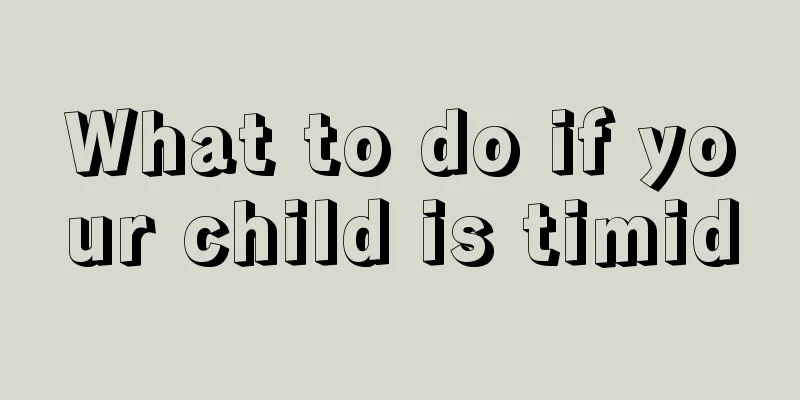What is the correct sleeping position for babies?

|
For parents, the health of their children is what they care about most. Especially for some younger infants and young children, their sleeping posture is very important. Good sleep can help the baby grow more healthily and quickly. Today I will introduce to you in detail some correct sleeping positions for babies. Correct sleeping position for babies When babies sleep, they must adopt the correct posture to enable them to grow and develop healthily. For this reason, parents must pay attention to their children's sleeping posture and correct some bad sleeping postures in time. However, medical experts do not agree on the best sleeping position for children, and the debate continues. The advantages and disadvantages of various sleeping positions are summarized as follows: (1) Sleep on your side. Some people believe that it is better for newborn babies to sleep on their side, which can completely relax the muscles of the whole body. Even if milk regurgitation occurs, it is not easy for vomitus to be inhaled into the respiratory tract, thereby causing the baby to suffocate. Sleeping on the right side is better than sleeping on the left side. It will not compress the heart and can promote the transfer of food in the stomach to the duodenum. However, opponents believe that always sleeping on one side will cause children's teeth to be misaligned. Because the development of the child's skull, face and jaw is synchronized with the development of the whole body, if the child often sleeps on one side, the compressed side will become flat and the top corner will protrude. When the child is sleeping on his side, you should use a pillow to block the side to prevent the child from sleeping on his stomach, which can easily cause suffocation. (2) Sleeping on your stomach. This refers to sleeping on your stomach. The prone sleeping position has been gaining popularity in recent years. This sleeping position can increase the activity of the baby's head, neck, and limbs, and promote the functions of organs such as the heart and lungs. However, it will make the baby's saliva difficult to swallow and cause saliva to flow out. Also, since babies cannot turn their heads or roll over, the bedding may block their mouths and noses, posing a risk of suffocation. Therefore, the bed for prone sleeping should be flat, not too soft, no pillows should be used, and the baby's feet should be placed properly. Many studies have shown that 83% of sudden infant deaths are related to babies sleeping on their stomachs. When children sleep in slippers, the pillow will press against the upper and lower jaws. If this continues for a long time, it will cause abnormal jaw development, resulting in a flat face. The face will not be on the same horizontal line, with either the upper front teeth outside the lower front teeth or inside the lower front teeth. Viewed from the side, the face is not full but sunken. Difficulty in waking infants who sleep on their stomachs reduces their ability to change positions and their ability to self-awaken in response to potentially fatal events. However, some people have pointed out from the results of psychological development research that when the baby sleeps on his stomach, when there is external stimulation, the baby's limbs and entire body have a mattress to rely on, allowing him to fall asleep peacefully without being frightened. When he grows up, his psychological quality is relatively stable. When sleeping on your stomach, the front-to-back diameter of the head is large and the left-to-right diameter is small, the occipital region does not appear flat, and the face is oval. People who advocate prone sleeping also believe that it is beneficial to the digestion of food in the stomach, reduces the reflux of food into the trachea, and is also beneficial for air to enter the lungs, keep the respiratory tract unobstructed, and reduce the occurrence of bronchial pneumonia. Therefore, some people believe that it is better for children over six months old to sleep on their stomachs. (3) Sleep on your back. When babies sleep on their backs, their muscles cannot be completely relaxed. If the baby's arms are placed on the chest accidentally for a long time, it will cause breathing difficulties and obstructed blood circulation. Sleeping on the back will make the baby lack a sense of "security" and cause the baby to fall asleep uneasily. Sleeping slumped over frequently will make the occipital region appear flat, the face rounder, the front-to-back diameter of the head smaller, and the left-to-right diameter larger. But according to the results of medical research, sleeping on your back can reduce the incidence of sudden infant death syndrome. Medical experts recommend that babies sleep on their backs to prevent sudden infant death syndrome. Therefore, infants under six months old should sleep on their backs. A report published in the November 1998 issue of the Journal of the American Academy of Pediatrics stated that sleeping on your back is not harmful to your baby's development. Although babies who sleep on their backs may not crawl or move as quickly as babies in other sleeping positions, they will catch up soon. Supine is a common sleeping position for babies. It helps to relax muscles and will not put pressure on internal organs, so the internal organs can move with less burden. However, lying on the back can cause the relaxed tongue root to fall back, sometimes blocking the airway and making breathing difficult for the baby. Especially for babies who have the habit of regurgitating milk, there is a risk of suffocation. At the same time, if babies under one year old sleep on their backs for a long time, their occipital bones will collapse and their heads will become flat. In short, when children are sleeping, parents should always pay attention to their children's sleeping posture, and help them correct any inappropriate posture if they find it. For children under 1 year old, parents should help them change their sleeping positions regularly so that they can develop a sleeping position that suits them and have a good head shape, thus ensuring their healthy development and growth. Through the detailed introduction above, everyone should now understand that it is very important for children to have the correct sleeping posture when they sleep at night. The above introduces in detail the correct sleeping positions for babies at night. I believe parents have mastered them! So in life, help your baby maintain the correct sleeping position so that they can sleep more healthily! |
<<: Why does my two-year-old baby grind his teeth when sleeping at night?
>>: Causes and treatments for children's bloating
Recommend
What is the best way to treat cerebral palsy in children?
Cerebral palsy is a common disease in children. I...
What to do if your baby doesn't sleep at night
Some babies will have some very strange phenomena...
My baby's eyes suddenly swelled up, what's going on?
Because the baby's physical development is no...
How to correct the symptoms of hunchback in children
If we want to correct the symptom of children'...
Lymph nodes on baby's head
Most people will be very worried when they hear a...
Baby, why is your hair falling out?
Every adult will experience hair loss, and it is ...
Is it okay for children to lose their teeth late?
Teeth are very important to each of us. Once teet...
What medicine should children take for constipation
Children's body functions are not fully devel...
Why do newborns hiccup?
There are always many problems with newborns, and...
What food can children eat when they have diarrhea?
Once a child eats the wrong food, he will have di...
What should babies eat if they have bad breath due to internal heat?
It is a very common situation for babies to get a...
Baby bath touch
After the baby is born, he needs to be bathed, an...
Baby's forehead is hot and body temperature is normal
Babies will have some diseases more or less durin...
What are the symptoms of dysphagia in infants with cerebral palsy?
Children with cerebral palsy need multi-faceted t...
Reasons for decreased appetite in two-month-old babies
In daily life, many mothers have found that many ...









